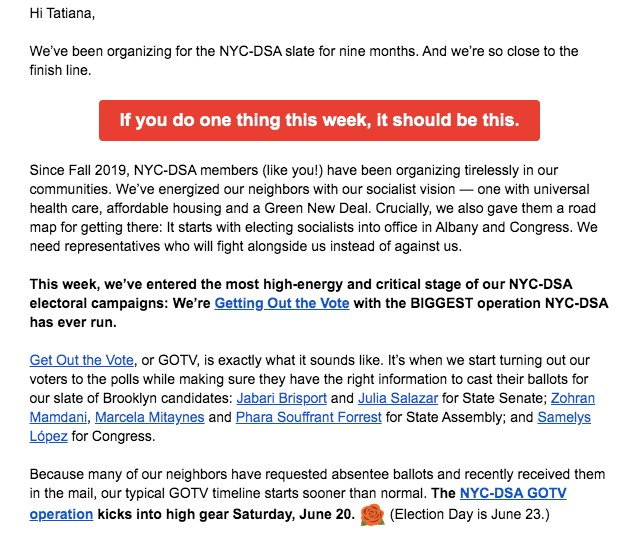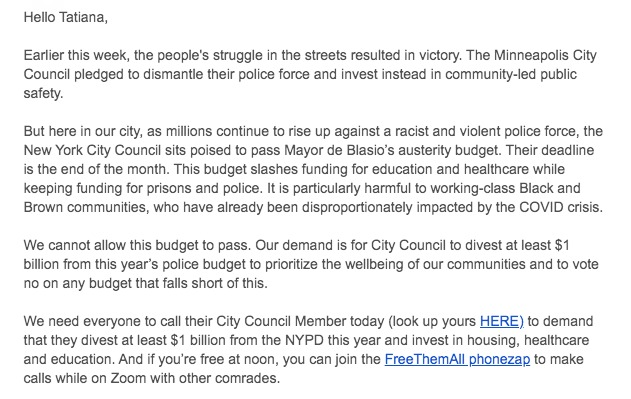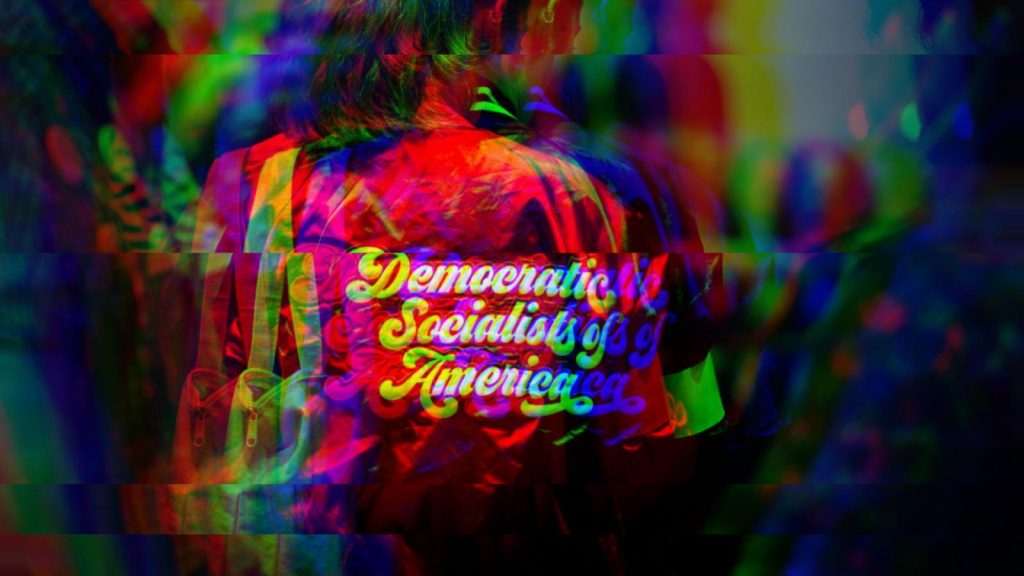In May 1968, rebellious students in France united with workers for a general strike. They read Marx, dreamed of revolution, questioned gender … Their motto was “Be realistic, demand the impossible.” They knew that the only realistic solution to the problems created by capitalism is to do what bourgeois theorists claim is impossible: overthrow the system in a socialist revolution.
The Democratic Socialists of America (DSA) was formed in 1982 by Michael Harrington. His goal for the new organization was to be “the left wing of the possible.” He wrote, “I share an immediate program with liberals in this country because the best liberalism leads toward socialism.” Harrington aimed to build a group whose “socialism” was just the illusion of a more humane capitalism, and whose strategy was to push the Democratic Party to take up reforms. Harrington’s strategy of “the possible” meant that socialists would play a role in limiting radical movements and bringing them back into the realm of bourgeois politics. It’s a failed strategy, not only in the fight for socialism but even in the fight for substantive reforms.
Clearly, a lot has changed since the 1980s. But these two frameworks — being the left wing of the “possible” or breaking with what is supposed to be “possible” under capitalism — are helpful to think about the DSA today.
At its (re)birth in 2016, tens of thousands of downwardly mobile young people joined the DSA. This was a product of the 2008 economic crisis, the Sanders campaign, and the bankruptcy of the Democratic Party under Hillary Clinton — and of the capitalist system more broadly.
The spirit was infectious: people awoke to political life and wanted profound change, even “the impossible.” This expressed itself primarily ideologically, not in radical mass actions. In those early years, there were real and deep questions within the DSA. What is the path to socialism? What is the role of elections? What could a revolution look like?
In the past four years, the DSA has answered those questions — in the spirit of Michael Harrington. The DSA has become an appendage of the Democratic Party, focusing almost exclusively on canvassing and phone banking for Democrats. After the coronavirus pandemic, the Black Lives Matter movement, and the January 6 debacle, the DSA is less combative than before, and despite having more than 80,000 members, it has failed to play a role in class struggle. Instead, the DSA has come to see class struggle as a way to strengthen electoral work in the Democratic Party.
With a National Convention taking place August 1–8, we should explore the role that the DSA is playing in the current political situation. Some semblance of capitalist normality is back: there are fewer protests and less outrage, while police murders continue and kids remain in cages. Instead of fanning the flames of struggle, the DSA is, in some ways, helping to put out the fire.
But 2020 has shown us that “impossible” scenarios — like mass uprisings in the heart of U.S. capitalism — are not just possible but probable as the capitalist system enters into crisis. The only realistic solution to the crisis is to demand what all reformists claim is impossible: going from revolt to revolution and fighting for a definitive break with capitalism to build a socialist future. This article will attempt to draw lessons from the problems in the DSA to prepare for the battles to come.
The DSA and Capitalist Crisis
The DSA has been around since the 1970s as a small reformist grouping. When Sanders began his presidential bid, the DSA had 5,000 members. By the start of 2019, membership exceeded 50,000, and now it is close to 100,000. This growth is a result of the crisis of capitalism.
Antonio Gramsci used the term organic crisis to describe a time of economic, political, and social turmoil that emerges from the failure of a capitalist project. This is precisely the situation in the United States after the 2008 crash threw the economy and neoliberalism itself into crisis. U.S. imperialist hegemony is on the decline, and China is emerging as a competitor on the world stage. In this situation, as Gramsci says, the “old is dying, and the new cannot be born.” The capitalists and their political parties cannot offer a clear way out of the crisis, and people begin to break away from the leaders and ideologies that they used to follow without question.
Left- and right-wing populism have emerged, with Donald Trump and Bernie Sanders. With Hillary Clinton’s loss, the Democratic Party stood discredited. A new generation emerged that is skeptical of capitalism and drawn to a vague notion of socialism. The emergence of the DSA is part of these elements of organic crisis. The huge support for socialism among the youth would have seemed impossible even a few years back.
The central task of the Biden administration is rebuild faith in capitalist institutions and restore U.S. imperialist hegemony. Biden’s program is to promote an “America First” capitalism as a way to compete with China, and spending packages are intended to relieve the worst of the economic crisis. Unlike what we hear from Sanders, Alexandria Ocasio-Cortez, or even Jacobin magazine, the task for socialists isn’t to coach Biden and the Democrats on how to rebuild capitalist institutions. And it isn’t to divorce minor reforms from their blatantly stated imperialist project. This is a strategy for the “left wing of the possible” — it’s a chauvinist strategy that looks to win reforms for some U.S. workers at the expense of the international working class. And the climate and economic crisis, the rot of capitalism, is increasingly clear, and “the possible” within capitalism is so clearly insufficient.
Socialists should be doing everything possible to deepen the crisis of capitalism, of the bipartisan regime, and of U.S. imperialism; when “the old is dying and the new cannot be born,” socialists should be aiming to kill the old and provide a political alternative to those radicalized by the crisis. The DSA is doing quite the opposite. It is shepherding this new generation back into the Democratic Party — not to bury the Democratic Party and U.S. capitalist “democracy” but to rejuvenate it with progressive and dynamic political figures.
And the Democratic Party is not just any party. Despite sometimes taking up the language of leftist movements, the Democratic Party is an imperialist and capitalist party. Unlike the Republicans, the Democrats have tentacles in working-class institutions like unions as well as in social movements. As the DSA becomes an appendage of the Democratic Party, it is therefore also becoming an appendage of the capitalist state, as are union bureaucracies and nonprofit bureaucracies, working to confine and constrain radicalism by channeling it into a bourgeois party. And while DSA folks do all kinds of theoretical gymnastics to claim that the way toward an independent working-class party is through the Democrats. But this ignores all the previous attempts to form a working-class party, which have been squashed by the Democratic Party and their bureaucratic allies in nonprofits and union leadership.
A DSA That Demanded the Impossible?
“When did you realize you were a socialist?” It’s 2017 and hundreds of new socialists crowded auditoriums and meeting halls to talk about when they realized the system we live in is wrong and that we need to fight to change it. At bars till late hours of the night, we discussed reform or revolution. In reading groups, we pored over Marx’s Capital. Any DSA member would tell you that this wasn’t Harrington’s group anymore. Many people who newly self-identified as revolutionaries found a home in the DSA, and some even argued that the DSA could be built into a revolutionary political party.
While plenty of DSA members identified as revolutionaries, it was difficult to find anyone who wanted to break with the Democratic Party. They disregarded the potential to build class consciousness with independent electoral campaigns and instead sought a shortcut to elected office through alliances with our class enemies. Here, the remnants of Harrington hung in the air, as people said: “The U.S. electoral system is so repressive that we have no choice but to run as Democrats.”
But even this was being questioned. At the 2017 DSA convention, two resolutions were put forward to distance the DSA from the Democratic Party, stating that
we should recognize that the Democratic Party is not our party, even if we sometimes run or support candidates within it. … We should refrain from endorsing or supporting Democrats engaged in political struggles within the Democratic Party. Taking part in such internal Democratic Party fights only disorients our members, leading them to believe that the Democratic Party can be a vehicle for the aspirations of working people. We believe it is important to emphasize this point because the Democratic Party has historically been the biggest challenge to progressive movements.
While the motion failed, it received two-fifths support, indicating that some in the DSA were skeptical toward the Democratic Party and had an initial understanding that the Democratic Party had always acted as the graveyard of social movements.
Jacobin and the Revival of Kautsky
Of course, not everyone in the DSA was new to socialism. Jacobin magazine and those who organized around it were the most theoretically and politically experienced DSA members — folks who had a theoretical and political vision. While most DSA members wouldn’t identify Jacobin as their political leadership, as the most organized members with a clear political vision, they played a hegemonic role, setting the agenda and leading the DSA to focus on the Sanders campaign and other electoral work.
Jacobin claimed the legacy of Karl Kautsky to justify an orientation of building the progressive wing of the Democratic Party. Kautsky represented the center of the German Social Democracy (SPD), the biggest socialist organization before World War I. Kautsky tried to balance between the revolutionary Left of Rosa Luxemburg and the SPD bureaucracy that ended up murdering her. Luxemburg described Kautsky’s strategy as “Nothing-but-Parlamentarism,” and Lenin famously wrote State and Revolution as a polemic against Kautsky’s reformist approach to the capitalist state. Yet Jacobin and the DSA are far to the right of Kautsky, who didn’t support capitalist politicians.
The Jacobin wing of the DSA seeks to divorce Kautsky from the SPD nationalist betrayal when the biggest socialist party in the world voted to support its own bourgeoisie in 1914. Luxemburg was one of the clearest voices fighting the SPD’s growing reformism even before this betrayal.
In 1911 the SPD refused to organize a conference about European imperialism in Morocco, claiming that the party needed to focus on domestic issues. This is precisely what Jacobin and the neo-Kautskyist wing of the DSA believe. Eric Blanc even claimed that “some leftists believe that we should not support Bernie because he is running on the Democratic Party ballot line and/or because of his political limitations (e.g. on foreign policy issues or his definition of socialism). This criticism is hardly a serious reason to withhold endorsement.” The message is to focus on domestic issues, to ignore imperialism in order to secure reforms for the U.S. working class. Luxemburg offered a compelling response:
They say that we should restrict our agitation exclusively to matters of domestic policy, to questions of taxation and social legislation. But financial policy … and the stagnation of social reform are organically bound up with militarism, naval policy, colonial policy, and with personal rule and its foreign policy. Any artificial separation of these spheres can only present an incomplete and one-sided picture of the state of our public affairs.
In other words, for Luxemburg, the struggle against capitalism required an understanding of the connection between foreign and domestic policy, and of the global economy as a whole. This lesson applies directly to the DSA, which overlooks imperialism to justify its support for Democrats. Foreign and domestic policy are one; to fight capitalism, one cannot divorce “domestic” reforms from foreign imperialism. But this is precisely the problem that has brought the DSA into the fold of the Democratic Party, especially now with Joe Biden in office, and Democrats running U.S. imperialism.
Yet this was not an overnight phenomena. This question of imperialism brought the DSA into regular conflict with its Kautskyist wing throughout the Trump era.
The Contradictions of the New DSA
The “new” DSA continued to grow throughout the Trump presidency. While elections were part of what the DSA did, in 2017 and 2018, many DSA members would angrily inform you that the DSA did more than elections: there was a lot of local and national activism as well. When Trump was organizing a coup in Venezuela, the national DSA encouraged a national day of action and called on DSA members to protect the Venezuelan embassy. Chapters organized protests to abolish ICE and, in some instances, to agitate for open borders.

This activism often stood in direct contradiction to electoral support for the Democrats. For example, Alexandria Ocasio-Cortez (AOC) and Sanders gave left cover to the coup in Venezuela. AOC voted for the ICE budget. Sanders was against open borders. The DSA was canvassing for people who actively opposed the causes for which DSA members were organizing protests and even getting arrested.
At times, the DSA made statements against the elected officials they had endorsed. The New York City DSA leadership criticized Ocasio-Cortez for her endorsement of Cuomo saying, “We reject the illusion that the Democratic Party is, or will become, an institution serving the interests of the U.S. working class.” In New York City, a fight about the endorsement of Cynthia Nixon took place, ending with an endorsement. But a letter signed by well over 100 NYC DSA member included strong statements, like “We believe that our fight for socialism lives or dies by the working class fighting for themselves, not by who sits in the governor’s mansion.”
Sectors of the DSA saw activism, not electoral politics, as their primary project. Yet many activists were willing to look the other way while the DSA built an electoral machine, hoping that the activist wing could peacefully coexist with the Democratic Party.
In reality, this meant making excuses for every contradiction as it emerged. DSA members ignored that Sanders is an imperialist politician who opposes open borders, hoping to at least win Medicare for All. This is the misery of “the possible,” which didn’t even deliver Medicare for All. The Sanders campaign was supposed to be a shortcut to the masses — but it was actually an entirely different road, and this road does not lead to socialism. Rather, the DSA’s electoral work was leading DSA activists to become auxiliaries for the Democratic Party and thus to the U.S. capitalist state.
The DSA was a tremendous help to the Democrats in a moment of massive crisis after the failure of Clinton’s 2016 campaign. People were seeking alternatives, but the DSA led them right back to the Democratic Party with young, progressive “socialists,” from AOC to Rashida Tlaib. This is exactly the opposite of what socialists should do when capitalist parties are in crisis. As Tre Kwon and Jimena Vergara argue, “When it appears the Democratic Party is going up in flames, revolutionaries and socialists should give their all to make the fire burn hotter. They should be pointing towards the absolute need for working-class organizations and a political party independent of capitalists, on the path towards socialist revolution and a classless society.”
Becoming a Democratic Electoral Machine
As the Sanders campaign for 2020 drew closer, there were questions within the DSA about whether to endorse him. The Afrosocialist Caucus wrote a statement asking the DSA to withhold an endorsement due to Sanders’s stance on reparations. In New York City, the Socialist Feminist Group held a panel discussion about the endorsement that I was on. When it came down to vote, there was essentially a tie between endorsing and not endorsing Sanders.
With the Sanders campaign, a slow drift toward the Democratic Party soon became a massive wave. Skepticism toward Bernie didn’t hold against Bernie mania, organized by Justice Democrats and high-profile supporters from Michael Moore to Killer Mike. Without a principled opposition to capitalist parties, the DSA committed itself to a notion of a kinder, reformed capitalism under a Sanders presidency. Comrades who were once critical of electoral work were now canvassing for Bernie every weekend.
And this time was different from 2016. Four years earlier, some people hoped that Bernie would break from the Democrats and launch an independent campaign. In 2020, even ardent Bernie supporters went in with open eyes — aware that Bernie wouldn’t break to form a new party, aware that the game was rigged in Joe Biden’s favor, aware that Bernie would endorse whoever the Democratic Party nominee was, aware that Bernie wasn’t a socialist, and aware that Bernie was an imperialist.
The DSA campaigned for Bernie 2020 without opposition. It mobilized its forces and created an army of phone bankers and canvassers who registered people as Democrats. It justified this theoretically, arguing that campaigning for Sanders was building socialism. Kate Doyle Griffiths highlights the folly of this:
The Democratic Party is oriented toward elections and not toward building labor and social movements, toward politics defined and constrained by a ruling class agenda, not toward building working class power. This is coldly material in the sense that money raised for say, the Bernie Sanders campaign, can’t then be reoriented toward extra-electoral efforts, and neither can internal party apparatus aimed at electing him or other left-wing Democrats — Our Revolution can’t legally be repurposed toward movement building and neither can the tens of millions that working class people donated to Bernie’s campaigns.
The DSA wasn’t building socialism — it built an electoral machine for the Democratic Party.
And as the coronavirus pandemic started, with fear, anger, and small labor walkouts, the DSA was left with an electoral machine in the midst of a Biden election campaign. Since the election, Sanders has become entirely integrated into the new administration as the head of the Senate Budget Committee. In seeking an illusory “kinder capitalism,” he has become a tool of the Biden administration, giving up on the very reforms that justified the DSA throwing all of its weight behind his campaign in the first place. And the “movement” the Sanders campaign and the DSA promised to build was toothless to fight for these reforms in the face of class struggle.
As Democrats were repressing BLM protesters and botching the response to the pandemic, the DSA did not get any closer to a “break” with the Democratic Party. In fact, the DSA is less likely to break now than it was four years ago. As Andy Sernatinger and Emma Wilde Botta explain,
Since 2016, the electoral debate in DSA has been about how to build an independent party. It was taken as a given that the Democratic Party is an obstacle, though the Bernie Sanders campaign opened up the possibility of tactical engagement with the Democratic Party as the socialist movement fought to move past it. Starting in 2020, the terms of the debate have shifted to whether to break from the Democratic Party at all.
Working within the Democratic Party takes on a particularly insidious character under the Biden administration. It means giving left cover to the party that holds the executive and legislative branches. It means fostering illusions that the party controlling the most powerful capitalist state in the world can be a vehicle for change. Meanwhile, the DSA’s army of canvassers is just not built for class struggle.
Failing the Tests of Class Struggle
2020 was in many ways the year of the “impossible,” from the Black Lives Matter movement to the coronavirus. It offered an abundance of opportunities to build working-class power and a fighting socialist organization. It was a test for the DSA’s claim that “we can do activism and elections.” Would the biggest socialist organization in decades in the United States, with elected representatives at city, state, and national levels, show that it could be as useful for supporting class struggle as for electing Democrats?
The answer is clear: the DSA failed every test of class struggle.
The Black Lives Matter uprising was the largest movement in recent U.S. history. It made the United States the most important hub of class struggle in the world during the pandemic. For a moment, the burning of a Minneapolis police station was more popular than either Trump or Biden; transportation workers refused to collaborate with the police; and millions of working-class people began to understand the role of the police as a pillar of structural racism. Largely organized spontaneously and without clear leadership, the movement forced the jailing of Derek Chauvin and put demands to defund or abolish the police on the political map.
The task of socialists is to take the revolts that inevitably break out in this rotten capitalist system and push to turn them into revolutions. In the biggest revolt of our lifetimes, what did the DSA do? It was canvassing for Democrats — the same party tear-gassing protesters in the streets. The DSA’s message to people out on the streets was that real change comes from voting and that protests are nothing more than pressure campaigns, not ways of strengthening the muscles and the anti-racist sensibilities of a working class deeply divided by structural racism. The DSA posed nothing nearing a perspective to overcome the U.S. capitalist state.
Individual DSA members were in the streets every day, many of them getting arrested. This isn’t about those individuals. This is about an organization with 80,000 or more members, with chapters in every state of the country, which failed to play any progressive role in the movement. Yes, local chapters, particularly local Afrosocialist groups, organized protests. But this was a far cry from what the biggest socialist organization in the country should have been able to do.
The DSA didn’t use its elected positions or its positions in the labor movement to strengthen the BLM movement. There was no national push to radicalize the movement or to connect the struggle against racism and police violence to the struggle against capitalism.
While the DSA did call to “Defund the police,” the strategy to win this demand was to canvass for local Democrats. It was not to push people to understand, as the 2017 statement at the DSA convention read, that “the Democratic Party has historically been the biggest challenge to progressive movements.” It was to shepherd a radical struggle in the streets into canvassing. On July 16, only three days before the biggest mobilizations of the BLM movement, the NYC DSA sent an email claiming, “If you do one thing this week, it should be this.” Not lead the fight against the police, but rather “get out the vote” for progressive Democrats.

DSA leaders saw the protests as little more than pressure campaigns — not a way to build the strength, organization, and class consciousness of the working class. Take the email the DSA sent about the movement to defund the NYPD on July 12:

Not a single mention of protest, mobilization, or radicalization. Not a single mention that Minneapolis’s promise to “abolish the police” was a cynical lie. To the DSA, electoral work was not meant to strengthen the movement. The movement was meant to strengthen the Democratic Party’s electoral work.
The DSA took less initiative than the longshore workers who organized a port strike, shutting down all the ports on the West Coast. They were less radical than the bus drivers who refused to transport prisoners for police. The DSA played absolutely no role in connecting the BLM movement to the labor movement: they launched no national campaign to get cops out of our unions or to make the “Strike for Black Lives” a real strike rather than a symbolic action. It played no role in making demands on and confronting the union bureaucracy that insisted on symbolic statements, no labor action and prepared the way to spend funds, money and time on electing Joe Biden.
While Eric Blanc claims to want to build a labor party, the DSA didn’t play any role in activating the labor movement around the Black Lives Matter and fighting for anti-racist activism within the working class — the only real way to unite the U.S. working class. While millions of workers were on the streets fighting racism, Jacobin held a reductionist approach of prioritizing “class-wide demands.”
With millions of people in the street, the DSA played no role in organizing forums, meetings, or discussions to organize the movement on a national scale. This meant leaving that political space for organizations that were not socialist and were entirely tied to the Democratic Party. As Haley Pessin explains, “In lieu of organizing activists to better agitate for their demands after the summer uprising, [Black Lives Matter Global Network Foundation] primarily directed its energy toward mobilizing voters to defeat Trump” and getting out the vote for Joe Biden. Thus, the enormous energy of the BLM movement was funneled into a “get out the vote” effort for Joe Biden. Now, of course, Biden is leading the charge against the demands of the BLM movement, moving to increase police budgets around the country.
This is not the only test of class struggle that the DSA failed in recent years. Though many DSA members are also union members active in their workplaces, the national organization’s orientation toward the labor movement is nothing more than mobilizing to pressure Congress to pass the PRO Act. Rather than building workers’ power — by launching an all-out national campaign in support of the unionization effort at Amazon in Bessemer, for example — the DSA funneled more energy into the Democratic Party and more faith into an administration whose purpose is to dispel the discontent of the last two decades.
Reform, Revolution, and the Misery of “the Possible”
In past conventions, there were lively debates about the direction of the DSA. How should the DSA engage with the working class? What is the path to a mass socialist party in the United States?
This upcoming convention shows a largely passive rank and file, entirely at peace with the focus on campaigning for the Democratic Party. This is evident in the fact that there are far fewer resolutions to be voted on this year than in past conventions: in 2019, there were 15 resolutions per 10,000 members. In 2021, there are four. The DSA is now again aligned with Harrington’s vision of being “the left wing of the possible” — even as the objective situation shows us that it is not possible to solve humanity’s most urgent problems under capitalism.
Nearly 100 years before Michael Harrington, Rosa Luxemburg wrote in “Opportunism and the Art of the Possible”:
Precisely because we do not yield one inch from our position, we force the government and the bourgeois parties to concede to us the few immediate successes that can be gained. But if we begin to chase after what is “possible” according to the principles of opportunism, unconcerned with our own principles, and by means of statesmanlike barter, then we will soon find ourselves in the same situation as the hunter who has not only failed to stay the deer but has also lost his gun in the process.
The DSA is a case in point. Eric Blanc argues that the DSA is “winning” because it endorsed many candidates who now hold elected office and because it is growing in numbers. But in the end, by tying itself to the Democrats, the DSA has made itself irrelevant in the only way that matters for socialists: in class struggle. Their “wins” are superficial — they are actually long term losses for a generation of young people who were moving away from a bourgeois party.
But 2020 showed that the “impossible” can happen. The year saw uprisings, global pandemics, and new neofascist movements unlike anything we’ve seen in our lifetimes. The only realistic response to capitalist destruction and misery is to overthrow this system. The 20th century was full of revolutions, and there is no sign that the 21st century will be different. But the role of socialists is decisive. Socialists need to treat every struggle as a school of war, as Lenin put it, to prepare the working class for revolution. And for this, we need an organization that is a real weapon against the racist, imperialist capitalist system and the parties that hold it up.


